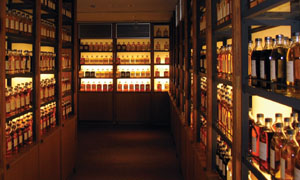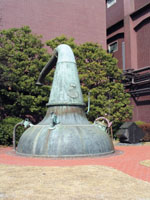Kansai: Suntory's World-Class Malts
Back to Contents of Issue: May 2004
|
|
|
|
by Dominic Al-Badri |
|
|
Premium malts became prized and pricey tipples, and trips to the motherland of the Scotch were able to satisfy two of the salaryman's strongest passions: golf (born in St. Andrew's) and malt whisky, readily available throughout the Highlands. Whisky-and-golf package tours became de rigeur for high-flying businessfolk in the 80s, and the Scotch were not slow to realize the potential of this wealthy market.
At the Glen Ord distillery in the Muir of Ord, I was startled by the number of special whiskies that were export-only, with most shipping to Japan. In off-license liquor shops throughout Japan there are myriad malt whiskies unavailable anywhere else in the world -- and, these days, on sale at prices that are nowhere near what they were during the bubble.
Suntory was founded in 1899 by Shinjiro Torii, and it was his passion for what is known in Gaelic as "uisge beatha" (lit. the "water of life"), that helped nurture Japan's love affair with the spirit. Today, Suntory is a huge international corporation offering a wide range of food and beverage products, but in its early days it was primarily involved in beer, and, from the 1920s onwards, whisky.
The distillery in Yamazaki remains in the same location to this day, and though, naturally, the facilities and buildings have been modernized, numerous original furnishings and pieces of equipment are still proudly on display near the visitor center. In this respect, Suntory is on top of the game when it comes to public relations. The free tours of the distillery are hugely popular, and not just with the bus-tour crowd. All manner of visitors were present when we went along recently, and being able to roam freely amongst the rows and rows of barrels (including some dating right back to the distillery's first days when the barrels were reconditioned Spanish sherry casks, still bearing the legend "Cadiz" firmly imprinted on their ends) was a treat not allowed on similar tours of Highland distilleries, at least not those we know about.
Last year, Suntory celebrated 80 years of whisky production and eagerly promoted its signature 12-year-old pure malt whisky, named after its most famous distillery, Yamazaki. And with good reason. In September, at the annual International Spirits Challenge, held in London, Yamazaki 12-year old became the first Japanese whisky to ever take home the gold medal. Japanese malt whisky has finally come of age, and though Japan does not have the peat which is used in Scotland -- and Ireland -- to smoke the whisky and give it its distinctive flavors, a cunning combination of local materials is used that, while unable to exactly mimic the effects of the peat, is able to give the spirit a unique taste. Nor is it just Suntory's whisky which is proving popular overseas. Another single malt, Nikka's Yoichi 10-year-old single cask came top at a 2001 tasting session organised by the UK's Whisky magazine.
However, because of whisky's association with the hardworking salaryman, the spirit suffered a slump in popularity roughly mirroring the downturn in the economy. During the 90s, less-alcoholic drinks, especially the various fruit-flavoured shochu concoctions known as chu-hai, surged in popularity, particularly as they appealed to women and a younger drinking crowd unused to the stronger flavors found in whisky. The Tory whisky bars set up in the 50s have almost all but disappeared, though one establishment which has managed to remain vibrant, with little time for passing fads and fashions, is located in Osaka's sleazy Juso district. Time has finally come full circle, however. Having never changed its decor since its opening in 1956, Juso Tory's Bar is now revered for its time-capsule atmosphere as much as for its collection of Suntory whisky.
|
|
Note: The function "email this page" is currently not supported for this page.


 The salaryman enjoying a glass of whisky after work has long been a staple image in postwar Japan. Cigarette in one hand, a tumbler of scotch in the other, Japanese men played out this role in the 1,500 Torys bars Suntory established in the 50s to cash in. As the nation prospered, so too did the whisky business.
The salaryman enjoying a glass of whisky after work has long been a staple image in postwar Japan. Cigarette in one hand, a tumbler of scotch in the other, Japanese men played out this role in the 1,500 Torys bars Suntory established in the 50s to cash in. As the nation prospered, so too did the whisky business.
 Torii himself had been an early convert to the wonders of whisky, but his opinion was seen as something of an anomaly, and he was heavily advised that the sprit's strength and fiery taste would be too much for the sensitive Japanese palate. In 1923, Suntory established Japan's first whisky distillery in Yamazaki, southwest of the city of Kyoto, near the border with Osaka Prefecture. Yamazaki is well-known locally as having exceptionally pure spring water -- an essential ingredient when making whisky. Torii persevered, against both a somewhat hostile local populace and with what was, initially at least, by all accounts a product more akin to firewater than a Highland malt. In 1937, after almost 15 years of experimentation, Kakubin, Japan's first authentic whisky, was launched. Though World War II brought an unwelcome interruption, Suntory picked up after the end of hostilities and now enjoys an unrivalled reputation as the country's top whisky producer.
Torii himself had been an early convert to the wonders of whisky, but his opinion was seen as something of an anomaly, and he was heavily advised that the sprit's strength and fiery taste would be too much for the sensitive Japanese palate. In 1923, Suntory established Japan's first whisky distillery in Yamazaki, southwest of the city of Kyoto, near the border with Osaka Prefecture. Yamazaki is well-known locally as having exceptionally pure spring water -- an essential ingredient when making whisky. Torii persevered, against both a somewhat hostile local populace and with what was, initially at least, by all accounts a product more akin to firewater than a Highland malt. In 1937, after almost 15 years of experimentation, Kakubin, Japan's first authentic whisky, was launched. Though World War II brought an unwelcome interruption, Suntory picked up after the end of hostilities and now enjoys an unrivalled reputation as the country's top whisky producer.
 At weekends the distillery is offline, to allow workers time off and for any essential maintenance work to be carried out. Nonetheless, walking through the cavernous spaces gives an ample feel of the scale involved. Weekday tours allow visitors to see the whole operation in process, though the smell and noise may be overpowering for some.
At weekends the distillery is offline, to allow workers time off and for any essential maintenance work to be carried out. Nonetheless, walking through the cavernous spaces gives an ample feel of the scale involved. Weekday tours allow visitors to see the whole operation in process, though the smell and noise may be overpowering for some.
 But it's not just a newly-found nostalgia that is driving the resurgent whisky boom. The prices of imported whiskies continue to fall, to the ridiculous point where many of the more popular and better-known Scottish blended whisky brands are cheaper here than they are in the UK Highly unusual single Scotch malts are available at discerning off-licenses in my neighborhood for prices unthinkable in Scotland, never minding the fact that you can't buy them there in the first place. But with the recent crowning of a local malt, Japanese whiskies no longer need to fear the presence of superior overseas brands. Unlike the world of wine, where Japan, though a hearty quaffer, is an under-producer, homegrown whisky is, at least, able to hold its own at the bar. Cheap whisky, and Japan produces enough of that, is cheap whisky wherever you go, but no longer can Japanese malt whisky be sneered at or sniffed upon. The Kansai region has had few things to smile about in recent times, but knowing we make a world-class malt whisky goes someway to easing the pain. Make mine a large one.
@
But it's not just a newly-found nostalgia that is driving the resurgent whisky boom. The prices of imported whiskies continue to fall, to the ridiculous point where many of the more popular and better-known Scottish blended whisky brands are cheaper here than they are in the UK Highly unusual single Scotch malts are available at discerning off-licenses in my neighborhood for prices unthinkable in Scotland, never minding the fact that you can't buy them there in the first place. But with the recent crowning of a local malt, Japanese whiskies no longer need to fear the presence of superior overseas brands. Unlike the world of wine, where Japan, though a hearty quaffer, is an under-producer, homegrown whisky is, at least, able to hold its own at the bar. Cheap whisky, and Japan produces enough of that, is cheap whisky wherever you go, but no longer can Japanese malt whisky be sneered at or sniffed upon. The Kansai region has had few things to smile about in recent times, but knowing we make a world-class malt whisky goes someway to easing the pain. Make mine a large one.
@ 


